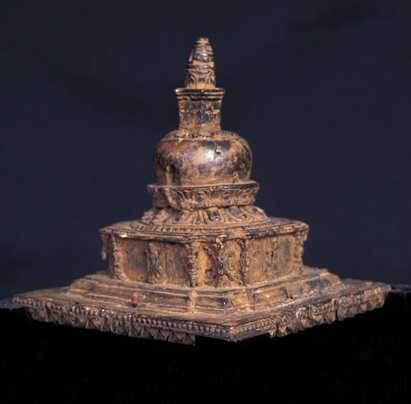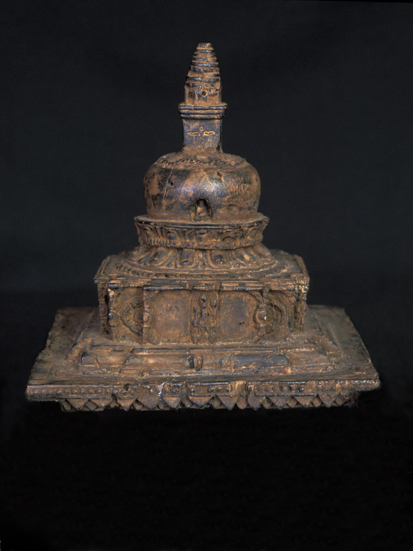Stûpa of the Heaped Lotuses (Padmâvali Chaitya)Nepal - Wood - Height 17cm-width 13cm - 17th centuryThe term “chaitya” or ”stupa” refers to a mound of earth or stone, the function of which was to mark the place where a funeral pyre has been built. The stupa has taken on greater importance in Buddhism, where it also serves as a shrine. For a long time this object replaced the image of the historical Buddha, Shâkyamuni, during an iconic phase of Buddhist art, and this symbolic identity between the stupa and the Buddha still remains the same today. Buddhist literature identifies a series of eight different kinds of stupas deriving from the Indian prototypes which were built, according to tradition, in each of the places connected with the life or teaching of Shâkyamuni. These stupas are commemorative monuments, and their function is to evoke both the four essential moments of Buddha’s earthly life, i.e. birth, enlightenment, first preaching and parinirvâna, as well as his four best-known miracles, his descent from the Tushita sky, the great miracle of Shravasti, the miracle of Vaishali, and the reconciliation of the dis- senters (1). The miniature stupa presented here belongs to the “heaped lotuses” (2)type, clearly visible above a lotus corolla supported by a quadrangular base. It can be connected to the stupa erected by Shuddhodana, father of Shâkyamuni, in the garden of Lumbinî in Kapilavastu when his son was born. That stupa was built to commemorate the child’s first seven steps, with the same number of lotus flowers blossoming from the earth upon the touch of his little feet (3). Indeed, Buddha’s two footprints, surrounded by lotus petals, are depicted beneath the base of this stupa. This kind of stupa is known as Padmâvali, meaning literally “row of lotuses” with reference to the nine petalshaped rings formed by the heaped lotuses. In Nepal, it is linked to the ancient symbology of the lotus flower, described in a legend of creation in which the flower appeared, having manifested itself, on the surface of lake Nâghrada. That lake covered the entire Nepal Valley, except for the hill of Svayambhû, where the most important stupa in the valley can be found today. According to tradition, the resplendent, selfgenerated flower had a million petals, symbolising its manifold qualities and corresponding to the same number of multiform manifestations of the universe (4). Most of the examples of Padmavâli Chaitya are found in the town of Patan, and the dates appearing on many of them span a period running from the 18th to the 20th century, although others may have been produced even earlier. There are four niches at the base of the domeshaped urn, corresponding to the most important part of the stupa. Each niche houses a Cosmic Buddha, presiding one of the four cardinal points. A Buddhas is also carved on each side of the base of the stupa, each Buddha being flanked by four Bodhisattvas, on either side of whom there is a stupa. The function of miniature stupas such as this one, besides that of enabling whomever commissioned their execution to accumulate merits, is connected to ceremoni- al and ritual Newar celebrations. During said celebrations, such stupas are exhibited by believers in the streets, forming a sort of long pathway of pilgrimage. These ritual processions are held in a number of centres in the valley at different times of the year (5) (1) Giuseppe Tucci, Indo-tibetica, vol. I, “Mc’od rten” e “Ts’a Ts’a” nel Tibet Indiano e Occidentale. Contributo allo studio dell’arte religiosa tibetana e del suo significato, Reale Accademia d’Italia, Roma 1923, pp. 23-24. (2) Ibidem. (3) Ibid., p. 14. (4) Niels Gutschow, The Nepalese Caitya. 1500 Years of Bud- dhist Votive Architecture in the Kathmandu Valley, Edition Axel Menges, London 1997, p. 271. (5) Ibid. pp. 77 and 79. ALC (Free Circulation) |

